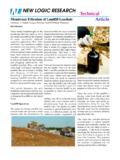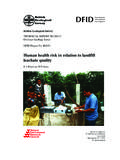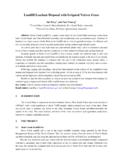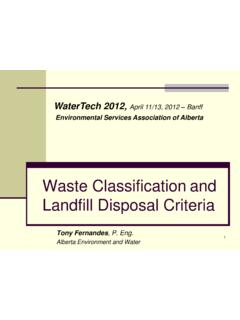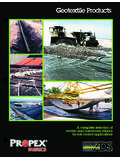Transcription of Leachate management: leachate generation, …
1 Leachte management 1. Heyer, R. Stegmann Leachate management: Leachate generation, collection, treatment and costs Heyer and R. Stegmann Ingenieurb ro f r Abfallwirtschaft, Prof. R. Stegmann und Partner phone: #4940 / 7711 0741 (42); fax: #49040 / 7711 0743. e-mail: internet: ABSTRACT. The control of Leachate quantity and quality is the basis for long-term landfill operation with minimized emissions and also for Leachate treatment. Biological processes as aerated lagoons or activated sludge plants are the most common practice for Leachate treatment. But the remaining values of COD and AOX are still high. This was the reason to develop physical-chemical treatment steps as alternative or additional treatment methods. Many experiences with these treatment methods have been made in the past. Although a lot of treatment plants for Leachate are under operation nowadays, the development is not yet finished.
2 Some results of operation and effluents and the corresponding costs are presented. INTRODUCTION. Sanitary landfill Leachate is a high and complex polluted wastewater. Leachate pollution is the result of biological, chemical and physical processes in landfills combined with waste composition and landfill water regime. A characteristic of this wastewater is the change of some components with the change of biological conditions in landfills. To secure long term dewatering of landfills and reduce increasing of treatment costs it is necessary to control Leachate quantity and quality. With increasing water quality standards the requirements on Leachate treatment also increases. Treatment procedures must consider the small flow rates and the complex composition which often results in special operation problems. The following chapters Ingenieurb ro f r Abfallwirtschaft Prof.
3 R. Stegmann und Partner, Hamburg Leachte management 2. Heyer, R. Stegmann should give an overview on Leachate generation, its development and standards of Leachate control and treatment. Leachate GENERATION: QUALITY AND QUANTITY. Leachate quality: aerobic and anaerobic biochemical processes Aerobic degradation phase: The first phase of aerobic degradation of organic substances is generally of limited duration due to the high oxygen demand of waste relative to the limited quantity of oxygen present inside a landfill (Phase I, Fig. 1). The only layer of a landfill involved in aerobic metabolism is the upper layer where oxygen is trapped in fresh waste and is supplied by diffusion and rainwater. In this phase it was observed that proteins are degraded into amino acids, thus into carbon dioxide, water, nitrates and sulphates, typical catabolites of all aerobic processes (BARBER, 1979).
4 Carbohydrates are converted to carbon dioxide and water and fats are hydrolysed to fatty acids and glycerol and are then further degraded into simple catabolites through intermediate formation of volatile acids and alkalis. Cellulose, which constitutes the majority of organic fraction of wastes, is degraded by means of extracellular enzymes into glucose which is used subsequently by bacteria and converted to carbon dioxide and water. This stage, due to the exothermal reactions of biological oxidation, may reach elevated temperatures if the waste is not compacted. Usually the aerobic phase is quite short and no substantial Leachate generation will take place. In very old landfills, when only the more refractory organic carbon remains in the landfilled wastes, a second aerobic phase may appear in the upper layer of the landfill. In this phase the methane production rate is so low that air will start diffusing from the atmosphere, giving rise to aerobic zones and zones with redox potentials too high for methane formation (CHRISTENSEN & K JELDSEN, 1989).
5 Ingenieurb ro f r Abfallwirtschaft Prof. R. Stegmann und Partner, Hamburg Leachte management 3. Heyer, R. Stegmann Phase I: Aerobic phase Phase II: Acid phase Phase III: Intermediate methanogenic phase Phase IV: Stabilized methanogenic phase Phase V: Final aerobic phase Figure 1. Illustration of developments in Leachate and gas in a landfill cell (CHRISTENSEN & K JELDSEN, 1989). Ingenieurb ro f r Abfallwirtschaft Prof. R. Stegmann und Partner, Hamburg Leachte management 4. Heyer, R. Stegmann Anaerobic degradation phases: Three different phases can be identified in the anaerobic decomposition of waste. The first phase of anaerobic degradation is acid- fermentation, which causes a decrease in Leachate pH, high concentrations of volatile acids and considerable concentrations of inorganic ions (for example, Cl-, SO42-, Ca2+, Mg2+, Na+).
6 The initial high content of sulphates may slowly be reduced as the redox potential drops and metal sulphides are gradually generated that are of low solubility and precipitate iron, manganese and other heavy metals that were dissolved by the acid-fermentation (CHRISTENSEN & KJELDSEN, 1989). The decrease in pH is caused by the high production of volatile fatty acids and the high partial pressure of CO2. The increased concentration of anions and cations is due to lixiviation of easily soluble material consisting of original waste components and degradation products of organic substances. Initial anaerobic processes are elicited by a population of mixed anaerobic microbes, composed of strictly anaerobic bacteria and facultative anaerobic bacteria. The facultative anaerobic bacteria reduce the redox potential so that methanogenic bacteria can grow.
7 In fact, the latter are sensitive to the presence of oxygen and require a redox potential below -330 mV. Leachate from this phase is characterized by high BOD 5 values (commonly > mg/l), high BOD 5/COD ratios (commonly > 0,7) and acidic pH values (typically 5 - 6) and ammonia (often mg/l) (ROBINSON, 1989), the latter due to hydrolysis and fermentation of proteinous compounds in particular. The second intermedial anaerobic phase (Phase III, Fig. 1) starts with slow growth of methanogenic bacteria. This growth may be inhibited by an excess of organic volatile acids which are toxic to methanogenic bacteria at concentrations of mg/litre (STEGMANN & SPENDLIN, 1989). The methane concentration in the gas increases, whilst hydrogen, carbon dioxide and volatile fatty acids decrease. Moreover, the concentration of sulphate decreases owing to biological reduction.
8 Conversion of fatty acids causes an increase in pH values and alkalinity with a consequent decrease in solubility of calcium, iron, manganese and heavy metals. The latter are probably precipitated as sulphides. Ammonia is released and is not converted in the anaerobic environment. The third phase (Phase IV, Fig. 1) of anaerobic degradation is characterized by methanogenic fermentation elicited by methanogenic bacteria. The pH range tolerated by methanogenic bacteria is extremely limited and ranges from 6 to 8. At this stage, the composition of Leachate is characterized by almost neutral pH values, low concentrations of volatile acids and total dissolved solids whilst biogas presents a methane content which is generally higher than 50 %. This confirms that solubilization of Ingenieurb ro f r Abfallwirtschaft Prof. R. Stegmann und Partner, Hamburg Leachte management 5.
9 Heyer, R. Stegmann the majority of organic components has decreased at this stage of landfill operation, although the process of waste stabilization will continue for several years and decades. Leachates produced during this phase are characterized by relatively low BOD values and low ratios of BOD/COD. Ammonia continues to be released by the first stage acetogenic process. In Table 1 the ranges of Leachate concentrations depending on the degradation phase for some relevant parameters are presented. EHRIG (1990) compiled Leachate concentrations from German landfills from the seventies and eighties. According to his evaluation the organics (COD, BOD 5, TOC) as well as AOX, SO4, Ca, Mg, Fe, Mn, Zn and Cr are determined by the biochemical processes in the landfill, there are striking differences between the acid phase and the methanogenic phase.
10 KRUSE (1994) investigated 33 landfills in Northern Germany, the Leachate concentrations mainly derive from the late eighties and early nineties. He defined three characteristic periods according to the BOD 5/COD-ratio: Acid phase: BOD 5/COD = 0,4. Intermediate phase: 0,4 > BOD 5/COD > 0,2. Methanogenic phase: BOD 5/COD = 0,2. Between the two investigations there are significant differences concerning the organic parameters. In the younger landfills (KRUSE, 1994) Leachate concentrations of COD, BOD 5 and TOC are lower than those determined by EHRIG (1990) some ten years before. This can be explained by developments in the technology of waste landfilling. In many younger landfills waste deposition and compaction in thin layers in combination with an aerobic pretreated bottom layer was carried out. This led to a reduction of the period for the acid phase and to an accelerated conversion of organic Leachate components to the gaseous phase, the degradation of organics to methane and carbon dioxide.

